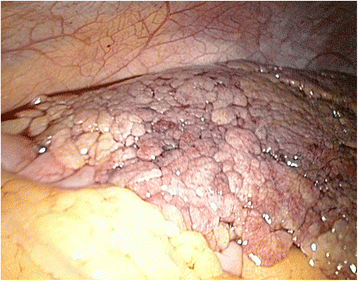Torsion of a bifid omentum as a rare cause of acute abdomen: a case report
- PMID: 27756378
- PMCID: PMC5070124
- DOI: 10.1186/s13256-016-1070-9
Torsion of a bifid omentum as a rare cause of acute abdomen: a case report
Abstract
Background: Omental torsion is a rare and very unusual cause of acute abdominal pain. If often mimics other acute pathologies and it is very difficult to diagnose preoperatively, which can lead to deterioration of the patient. It is seldom reported in the literature.
Case presentation: We report a well-documented case of a 67-year-old white woman who complained about abdominal pain, which was slowly increasing in severity. She had no previous abdominal interventions. An abdominal ultrasound showed multiple gallstones. At laparoscopy, free hemorrhagic fluid was seen and further exploration showed torsion of the right part of her omentum. A partial omentectomy was performed. Her postoperative course was uneventful.
Conclusions: Omental torsion is a rare cause of abdominal pain. Primary omental torsion is seldom reported in the literature. Blood examinations are frequently normal. Abdominal ultrasound and computed tomography can exclude other pathologies. Exploration remains the preferred diagnostic and therapeutic modality. Surgeons should include the diagnosis of omental torsion in their differential diagnosis of acute abdominal pain.
Keywords: Acute abdomen; Omental torsion; Surgical resection.
Figures





References
-
- Eitel CG. Rare omental torsion. NY Med Rec. 1899;55:715.
Publication types
MeSH terms
LinkOut - more resources
Full Text Sources
Other Literature Sources
Medical

